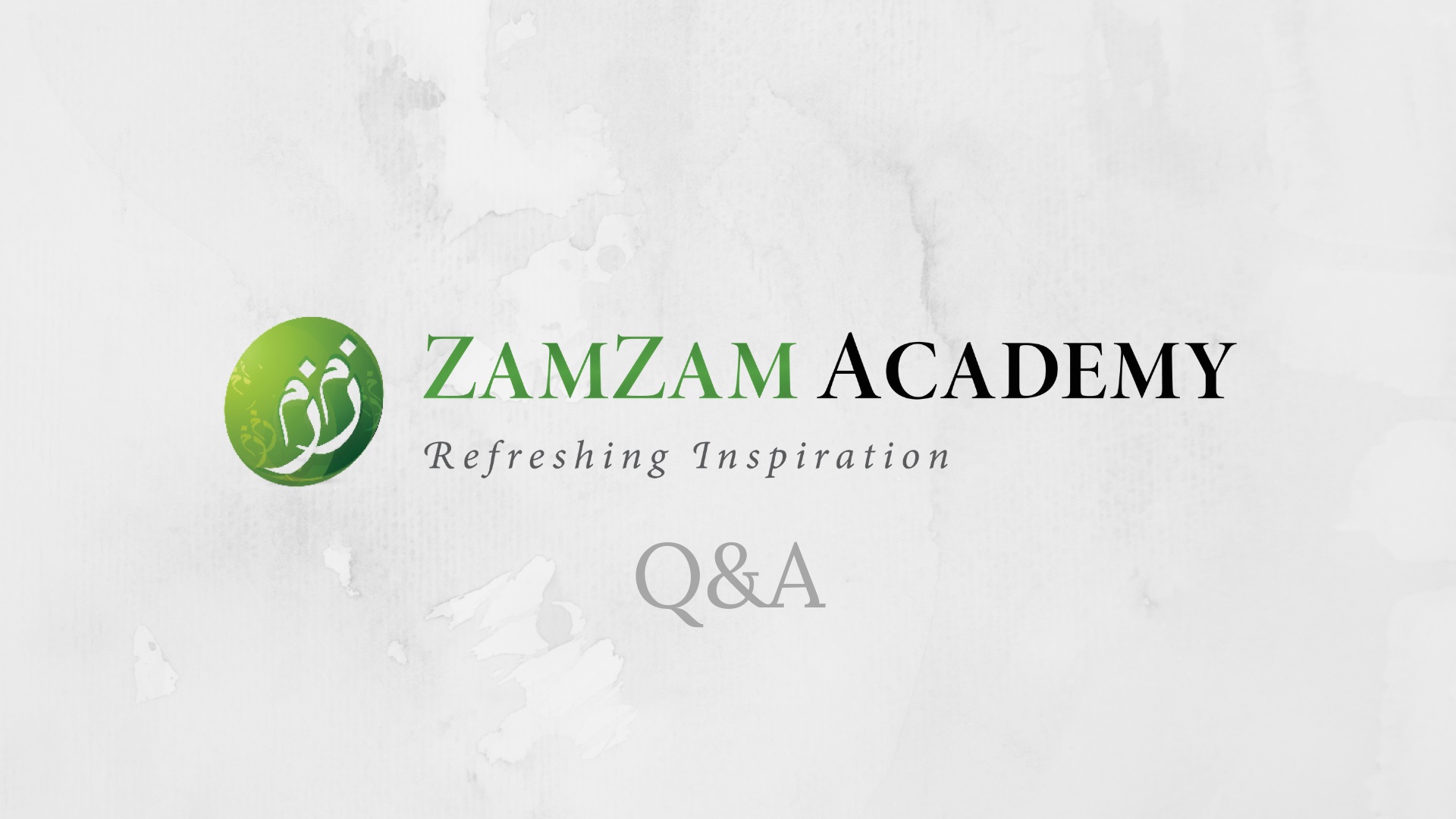
Raising of The Hands in Salah
Question
Why don’t Hanafis raise their hands when going into ruku or raising their heads from ruku`?
Isn’t this against the sunna of the Prophet (Allah bless him and give him peace) who said, “Pray as you have see me praying.”?
Answered by: Mufti Abdurrahman ibn Yusuf
Assalamu alaykum
In the name of Allah, Most Gracious Most Merciful
The correct position ibn the Hanfi school is to only lift the hands at the opening takbir and then not to lift them again. (Haskafi/Ibn `Abidin, Radd al-Muhtar `ala al-Durr al-Mukhtar, 1.340, Bulaq ed.)
This is well established throught the hadiths of great Companions of the Prophet (Allah bless him & give him peace) like ‘Abdullah ibn Mas’ud, ‘Abdullah ibn ‘Umar and many others (Allah have mercy on them). Likewise this is also the position of the Maliki school.
The following may be usefull to understand this is issue more clearly.
(Excerpted from Chapter 5: Raising the Hands for Ruku – from the third edition of Fiqh al-Imam, which explains the evidence for important legal positions of the Hanafi school.)
Raising the Hands for Ruku
The Differences Found in the Narrations
The hadiths regarding raising the hands are of three types:
(1) There are those which clearly mention that the Messenger of Allah (Allah bless him and give him peace) raised his hands at the time of bowing (ruku).
(2) Secondly, there are those which mention that the Messenger of Allah (Allah bless him and give him peace) never raised his hands except when uttering the opening takbir (tahrima).
(3) And thirdly, there are those hadiths which describe the complete prayer of the Messenger of Allah (Allah bless him and give him peace), but do not mention whether or not he raised his hands after the opening takbir.
The hadiths of the first category stand as evidence for group one, those whose opinion is of raising the hands; whereas the second category of hadiths stand as evidence for those whose opinion is not to raise the hands. Although the hadiths of the first category seem to outnumber those of the second, this does not mean anything, because the hadiths of the third category could also be used in conjunction with the second as evidence for not raising the hands. The reason for this is that not mentioning something only proves that it was not a popular practice. It is also very difficult to accept that while demonstrating the prayer of the Messenger e, a narrator could have failed to mention something as significant as raising the hands, had it been an important aspect of the prayer. Hence, by utilizing the hadiths of the third category as complimentary evidence for the second category, the hadiths in support of not raising the hands would actually outnumber those in support of it.
To elaborate further, it must be understood that the Messenger of Allah”s not raising his hands (Allah bless him & give him peace) is a nonexistent action, and people do not mention nonexistent actions in their conversations. For instance, if an individual returning home from the masjid, happened to fall down and hurt himself, the report would most certainly state, “He fell down,” since his falling down became an existent action (something that actually took place). On the other hand, if this same person arrived home without any accident, nobody would unduly remark, “He did not fall,” since this is a nonexistent action. It is just another one of several hundred other such actions that did not occur.
The case of these hadiths is similar because, since the Messenger of Allah (Allah bless him and give him peace) did not raise his hands at all, the narrators did not report it. If it had been a regular practice of the Messenger (Allah bless him & give him peace), which he had failed to observe at times, the narrator would certainly have mentioned it. This can be likened to the example of a person who has a fixed time for eating. If for some reason he failed to eat at that time, someone could remark that he did not eat, since eating at that time should have been an existent action for him, which did not occur. Nobody would comment on his not eating at any other time, since eating at other times is normally nonexistent for this person, and nonexistent actions are normally not mentioned. Now, the hadith of the third category do not mention anything about the raising of the hands being a habitual action of the Messenger of Allah (Allah bless him and give him peace). As a result these hadiths can also be used as evidence with those of the second category for the Hanafi point of view. This would significantly increase the number of hadiths in favour of the Hanafi opinion, and outnumber the hadiths of the first category.
The Hadith on Raising the Hands
Group one normally presents the narrations of Ibn practise (Allah be pleased with them) and Malik ibn al-Huwayrith (Allah be pleased with them)as their primary source of evidence, since both of these Companions have reported the raising of the hands at the time of bowing (ruku”). However, both of these Companions have also reported the raising of the hands regarding all the seven instances mentioned above. Group one has only accepted those narrations of the two Companions which mention that the Messenger e raised his hands at the opening takbir and when bowing, and have disregarded the other narrations.
The Hanafi scholars did not based their opinion on this type of narrations, but have rather based it on those reports whose narrators are consistent. Their primary source are the narrations of ‘Abdullah ibn Mas’ud (Allah be pleased with them)who states that the hands were raised at the initial takbir (al-tahrima) only, and not repeated at any other time in the prayer. All reports from him explain the same practice.
Now we come to the issue of the narrations of ‘Abdullah ibn ‘Umar, which are normally quoted by those who claim that the Messenger e frequently raised his hands in salat. It is well known that Imam Malik received many narrations from “Abdullah ibn ‘Umar (Allah be pleased with him and his father) . In fact, his famous chain which runs through Nafi” to ‘Abdullah ibn ‘Umar (Allah be pleased with him), and is well known as “The Golden Chain” (silsilat al-dhahab). However, in this issue, Imam Malik did not base his opinion on these narrations, but rather adopted the narrations of Ibn Mas’ud (Allah be pleased with them) instead, and gave preference to the practice (ta’amul) of the people of Medina which was to raise the hands at the initial takbir only.
Secondly, Ibn Abi Shayba and Imam Tahawi have narrated another hadith of Ibn ‘Umar (Allah be pleased with him and his father) through Mujahid, in which again there is no mention of raising the hands. If this was a constant practice of the Messenger of Allah (Allah bless him and give him peace), then why was it not mentioned in this narration.”
Furthermore, although there are many hadiths of Ibn ‘Umar (Allah be pleased with him and his father) regarding the raising of the hands, there are many inconsistencies found in them. Such confusion in the reports of a narrator, will not allow his narrations to be adopted in the presence of other reports which are more precise and consistent. For example, in one of his narrations, which is mentioned in Imam Tahawi’s Mushkil al-Athar, it states that the hands were raised at every movement of the prayer, whereas in his other narrations, this is not mentioned.
The Hadith on Not Raising the Hands
We will now present the narrations of various Companions, including those of Ibn ‘Umar, which state that the Messenger raised his hands for the opening takbir only.
1. ‘Alqama reports that ‘Abdullah ibn Mas’ud (Allah be pleased with them) said:
“Should I not demonstrate the prayer of the Messenger of Allah (Allah bless him and give him peace) for you” He performed the prayer, and did not raise his hands except at the initial takbir (Sunan al-Tirmidhi 1:59, Sunan al-Nasa’i 1:161, Sunan Abi Dawud 1:116).
Imam Tirmidhi classifies this hadith as sound (hasan). “Allama ibn Hazm classifies it as rigorously authenticated (sahih) (al-Muhalla 4:88), and “Allama Ahmad Muhammad Shakir, rejecting the criticism of some scholars, writes in his commentary of Sunan al-Tirmidhi, “This hadith has been authenticated by Ibn Hazm and other hadith masters (huffaz), and whatever has been stated about it containing defects is incorrect.” It is mentioned in the al-Jawhar al-naqi that its narrators are those of Sahih Muslim” (I’la’ al-sunan 3:45).
2. ‘Alqama reports that ‘Abdullah ibn Mas”ud (Allah be pleased with him) asked:
“Should I not inform you of the Messenger of Allah’s (Allah bless him & give him peace) prayer” ” He stood up and raised his hands at the outset and did not do so again (Sunan al-Nasa’i 1:158, I’la’ al-sunan 3:48).
3. ‘Alqama narrates from ‘Abdullah ibn Mas’ud (Allah be pleased with him):
The Messenger of Allah (Allah bless him and give him peace) would raise his hands at the opening takbir, then would not raise them again (Sharh Ma’ani ‘l-athar 224).
4. ‘Abdullah ibn Mas’ud (Allah be pleased with them) narrates:
I performed prayer with the Messenger of Allah (Allah bless him and give him peace), Abu Bakr and ‘Umar (Allah be pleased with him and his father). They did not raise their hands except at the beginning of prayer (Nasb al-raya 1:526, Majma’ al-zawa’id 2:101).
Judging from the above hadiths, it can be concluded quite easily that the Messenger did not raise his hands regularly during the course of prayer. Ibn Mas’ud, “Ali and other Companions (Allah be pleased with them) would never have narrated such reports had they observed the Messenger of Allah (Allah bless him and give him peace) and the Caliphs (khulafa’) regularly raising their hands” It has also been observed that all the narrations of Ibn Mas’ud (Allah be pleased with them) are consistent in that they relate the hands being raised only at the beginning of prayer and not at any other instance.
Finally ‘Urwa ibn Murra states:
When I entered the masjid (mosque) of Hadramawt, I heard ‘Alqama ibn Wa’il narrate from his father that the Messenger (Allah bless him & give him peace) would raise his hands before and after the bowing posture. I mentioned this to Ibrahim al-Nakh’a (Allah have mercy on him) who responded angrily, “Is Wa’il ibn Hujr the only one to have seen the Messenger (Allah bless him & give him peace) Didn’t Ibn Mas’ud (Allah be pleased with him) and his companions also see him? ” (Muwatta Imam Muhammad 92).
Wassalam
Mufti Abdurrahman ibn Yusuf








![[ID: xlHQZuOVhp0] Youtube Automatic](https://www.zamzamacademy.com/wp-content/uploads/2020/03/id-xlhqzuovhp0-youtube-automatic-236x133.jpg)
